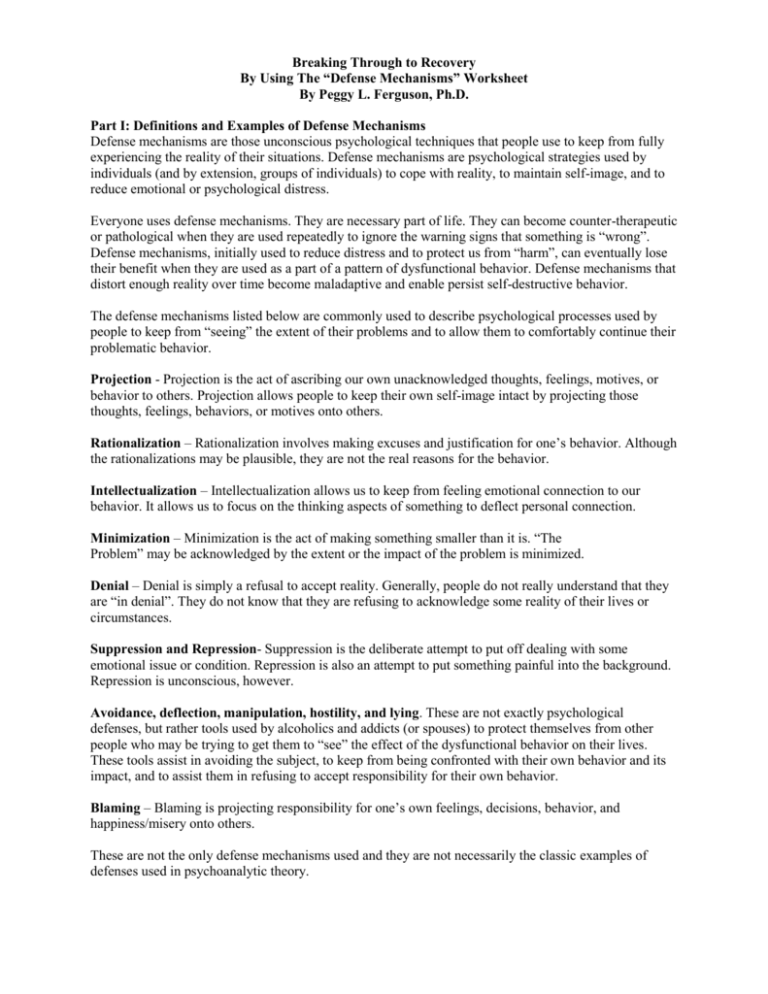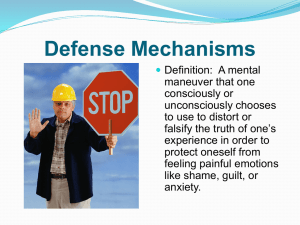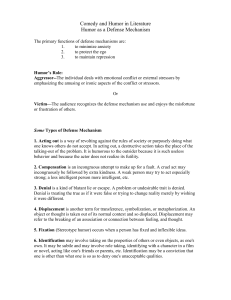Worksheet - Fulton County Schools
advertisement

Breaking Through to Recovery By Using The “Defense Mechanisms” Worksheet By Peggy L. Ferguson, Ph.D. Part I: Definitions and Examples of Defense Mechanisms Defense mechanisms are those unconscious psychological techniques that people use to keep from fully experiencing the reality of their situations. Defense mechanisms are psychological strategies used by individuals (and by extension, groups of individuals) to cope with reality, to maintain self-image, and to reduce emotional or psychological distress. Everyone uses defense mechanisms. They are necessary part of life. They can become counter-therapeutic or pathological when they are used repeatedly to ignore the warning signs that something is “wrong”. Defense mechanisms, initially used to reduce distress and to protect us from “harm”, can eventually lose their benefit when they are used as a part of a pattern of dysfunctional behavior. Defense mechanisms that distort enough reality over time become maladaptive and enable persist self-destructive behavior. The defense mechanisms listed below are commonly used to describe psychological processes used by people to keep from “seeing” the extent of their problems and to allow them to comfortably continue their problematic behavior. Projection - Projection is the act of ascribing our own unacknowledged thoughts, feelings, motives, or behavior to others. Projection allows people to keep their own self-image intact by projecting those thoughts, feelings, behaviors, or motives onto others. Rationalization – Rationalization involves making excuses and justification for one’s behavior. Although the rationalizations may be plausible, they are not the real reasons for the behavior. Intellectualization – Intellectualization allows us to keep from feeling emotional connection to our behavior. It allows us to focus on the thinking aspects of something to deflect personal connection. Minimization – Minimization is the act of making something smaller than it is. “The Problem” may be acknowledged by the extent or the impact of the problem is minimized. Denial – Denial is simply a refusal to accept reality. Generally, people do not really understand that they are “in denial”. They do not know that they are refusing to acknowledge some reality of their lives or circumstances. Suppression and Repression- Suppression is the deliberate attempt to put off dealing with some emotional issue or condition. Repression is also an attempt to put something painful into the background. Repression is unconscious, however. Avoidance, deflection, manipulation, hostility, and lying. These are not exactly psychological defenses, but rather tools used by alcoholics and addicts (or spouses) to protect themselves from other people who may be trying to get them to “see” the effect of the dysfunctional behavior on their lives. These tools assist in avoiding the subject, to keep from being confronted with their own behavior and its impact, and to assist them in refusing to accept responsibility for their own behavior. Blaming – Blaming is projecting responsibility for one’s own feelings, decisions, behavior, and happiness/misery onto others. These are not the only defense mechanisms used and they are not necessarily the classic examples of defenses used in psychoanalytic theory. Name: ____________________________ Date: _____________________ Part II The Defense Mechanisms Worksheet By Peggy L. Ferguson, Ph.D. Using the descriptions of defense mechanisms given above, give two (2) everyday examples of these defenses l. Projection: a: ____________________________________________________________________ ____________________________________________________________________ b: ____________________________________________________________________ ____________________________________________________________________ 2. Rationalization: a: ____________________________________________________________________ ____________________________________________________________________ b: ____________________________________________________________________ ____________________________________________________________________ 3. Intellectualization: a: ____________________________________________________________________ ____________________________________________________________________ b: ____________________________________________________________________ ____________________________________________________________________ 4. Minimization: a: ____________________________________________________________________ ____________________________________________________________________ b: ____________________________________________________________________ ____________________________________________________________________ 5. Denial: a: ____________________________________________________________________ ____________________________________________________________________ b: ____________________________________________________________________ ____________________________________________________________________ 6. Suppression: a: ____________________________________________________________________ ____________________________________________________________________ b: ____________________________________________________________________ ____________________________________________________________________ 7. Avoidance: a: ____________________________________________________________________ ____________________________________________________________________ b: ____________________________________________________________________ ____________________________________________________________________ 8. Deflection: a: ____________________________________________________________________ ____________________________________________________________________ b: ____________________________________________________________________ ____________________________________________________________________ 9. Manipulation: a: ____________________________________________________________________ ____________________________________________________________________ b: ____________________________________________________________________ ____________________________________________________________________ 10. Hostility: a: ____________________________________________________________________ ____________________________________________________________________ b: ____________________________________________________________________ ____________________________________________________________________ 11. Lying: a: ____________________________________________________________________ ____________________________________________________________________ b: ____________________________________________________________________ ____________________________________________________________________ 12. Blaming: a: ____________________________________________________________________ ____________________________________________________________________ b: ____________________________________________________________________ ____________________________________________________________________ Part III For each of the following situations, choose the defense mechanism that best fits the explanation. Choices: repression, reaction formation, regression, displacement, sublimation, denial, rationalization, or compensation. 1. _________________________________ Even a top baseball player will sometimes strike out on an easy pitch. When this happens, his next action may be to throw his bat or kick the water cooler with all his might 2. _________________________________ Soldiers exposed to traumatic experiences in concentration camps during wartime sometimes had amnesia and were unable to recall any part of their ordeal 3. ___________________________ The mother of an unwanted child may feel guilty about not welcoming her child. As a result, she may try to prove her love by becoming overindulgent and overprotective of the child 4. ___________________________ Mrs. Brown often accuses other women of talking too much and spreading rumors. It is rather obvious to those who know her that she is revealing her own inclinations in that area 5. ___________________________ Paul, an aggressive child, had problems in elementary school, as he would frequently fight with other children. Paul found when he entered high school that he could channel this hostility into sports such as football and soccer 6. ___________________________ The habitual drinker may insist that he really doesn't care much for the taste of alcohol but feels that he is obliged to drink with friends "just to be sociable 7. ___________________________ Mrs. James can't understand why her husband has been so grumpy and irritable for the past week. It certainly isn't her fault that he didn't receive the anticipated promotion at the factory 8. ___________________________ Parents might be reassured to know that children who pull wings off flies and jab pins in the dog may eventually find their niche in the areas of dentistry or surgery 9. ___________________________ Mike is always trying to impress his pals with how strong and independent he has become. However, when Mike has social or emotional problems, he still wants his dad to figure out the solution 10. ___________________________ A student forgot that his dreaded final exam in geometry was scheduled for Friday. This seemed unusual as the date of the exam had been marked on his calendar for several weeks






